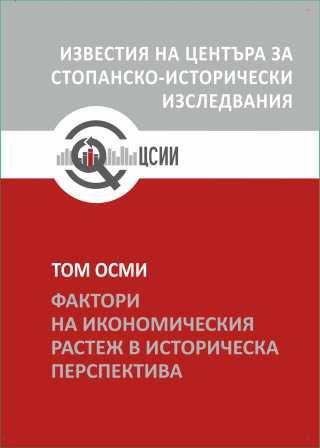ХАРАКТЕРИСТИКИ И ФАКТОРИ НА ИКОНОМИЧЕСКИЯ РАСТЕЖ В БЪЛГАРИЯ (1970–2008)
CHARACTERISTICS AND FACTORS OF ECONOMIC GROWTH IN BULGARIA (1970–2008)
Author(s): Stela RalevaSubject(s): History, Economy, National Economy, Business Economy / Management, Marxist economics, Comparative history, Economic history, History of ideas, Political history, Social history, Recent History (1900 till today), Human Resources in Economy, Socio-Economic Research
Published by: Център за стопанско-исторически изследвания
Keywords: economic growth; GDP structures; growth accounting; growth decomposition; employment; capital; factor productivity
Summary/Abstract: The paper provides an analysis of the economic growth in Bulgaria over a forty-year period, which includes the last two decades of the command system and the time from the beginning of the transition to market economy to the 2009 crisis. It discusses the specificities in the chain growth rates of real GDP and real GDP per capita in the various stages of the period, measured by using data from different sources. The dynamics of the production and the income structure of GDP are characterized and the most important structural changes are highlighted. The main focus of the study is on the supply-side determinants of economic growth. To this end, the growth rate of real GDP per capita is decomposed into growth rates in employment and the impact on GDP growth of changes in employment, capital accumulation and total factor productivity is assessed. In the course of the study, the existence of three periods in the dynamics of GDP, distinguished by internal heterogeneity, is proved. Changes in the sectoral structure are generally in the direction of increasing the share of services and reducing the share of agriculture, with relatively smooth changes in the share of industry. The income structure of GDP during command system was relatively stable and dominated by labour income, while afterwards the share of the capital income prevailed. Changes in GDP per capita depend mainly on average labour productivity, while the contribution of labour was insignificant in the first period, it was relatively high positive or negative in the first decade of transition, and persistently positive after2000. The relative importance of growth factors has varied over time, with capital leading in years of relatively high growth rates. The impact of total factor productivity is positive in most years and negative at the beginning of the transition and at the end of the period, combined with alternating negative and positive contributions from labour. Economic growth was intense in certain years during socialism and at the beginning of the third period, while during the rest of the time it was of extensive nature.
Journal: Известия на Центъра за стопанско-исторически изследвания
- Issue Year: VIII/2023
- Issue No: 1
- Page Range: 209-221
- Page Count: 13
- Language: Bulgarian

